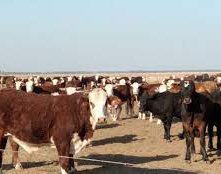Cattle are dying in droves in Somalia, which is experiencing one of the worst droughts in the country's recent history. Drought has become a major problem also for Argentine ranchers. About 26 million cattle are at risk of dying from lack of water and feed. From Africa to South America, the phenomenon of drought, which began in 2020, shows consequences in sectors that affect everything from trade to the economy, the environment, wildlife and finally industry that relies on agricultural resources and livestock.
The Horn of Africa is suffering from one of its most severe droughts in recent history. The rains failed three seasons in a row, spiraling the majority of the country into severe drought, with some areas facing the worst conditions in 40 years. Internal displacement from the drought has more than doubled in recent months, now reaching nearly 700,000 people. That is projected to double yet again to 1.4 million people as the situation worsens.
By May, it's projected that about 30% of the country might not have enough to eat. At least 4.5 million people have already been affected by the prolonged drought. Across the Horn of Africa, 13 million people face severe hunger.
The Paraná River is the second longest river in Latin America and is of utmost importance for the economy, ecosystem and population of all countries that cross it. Over the years, the consequences brought by the drought situation increase in magnitude and, although they are not all visible to citizens, it is clear that they affect society to a greater extent than is believed.
The decrease in the flow of the river can be attributed to two main factors: the alteration of the rainfall trend due to global warming and the deforestation of the Amazon, since it is the jungle trees that release steam into the atmosphere which then falls in the form of rain, which supplies the Paraná.
In environmental matters, river drought has had negative effects on livestock, agriculture and fish species. As detailed by Santa Fe's Minister of Production, Daniel Costamagna, about 3,000 head of cattle were lost due to extreme drought in the north of the province. In a conversation with radio station LT10Santa Fe, the official said that "about 10,000 cattle have died right now."
The Paraná River, together with the Paraguay River, its tributary, forms the so-called Paraná-Paraguay waterway, which connects the ports of Argentina, Bolivia, Paraguay, Uruguay and Brazil, and is more than 3,400 km long. The watercourse is one of the most important water reserves in the world, both for the flow of the rivers that enter it, for the biological diversity of the area, and for the great economic activity that takes place there. Of course, this natural and commercial source of Latin America is also affected by drought.
Most of the waterway passes through Argentina. The drought situation has caused a significant increase in costs for the agro-industrial sector exporting upstream, the area that brings together the most important ports of the country. The possibility of loading fewer tons per ship and relocating cargo by land increases the cost of placing production on foreign markets and decreases the competitiveness of the Argentine market.



